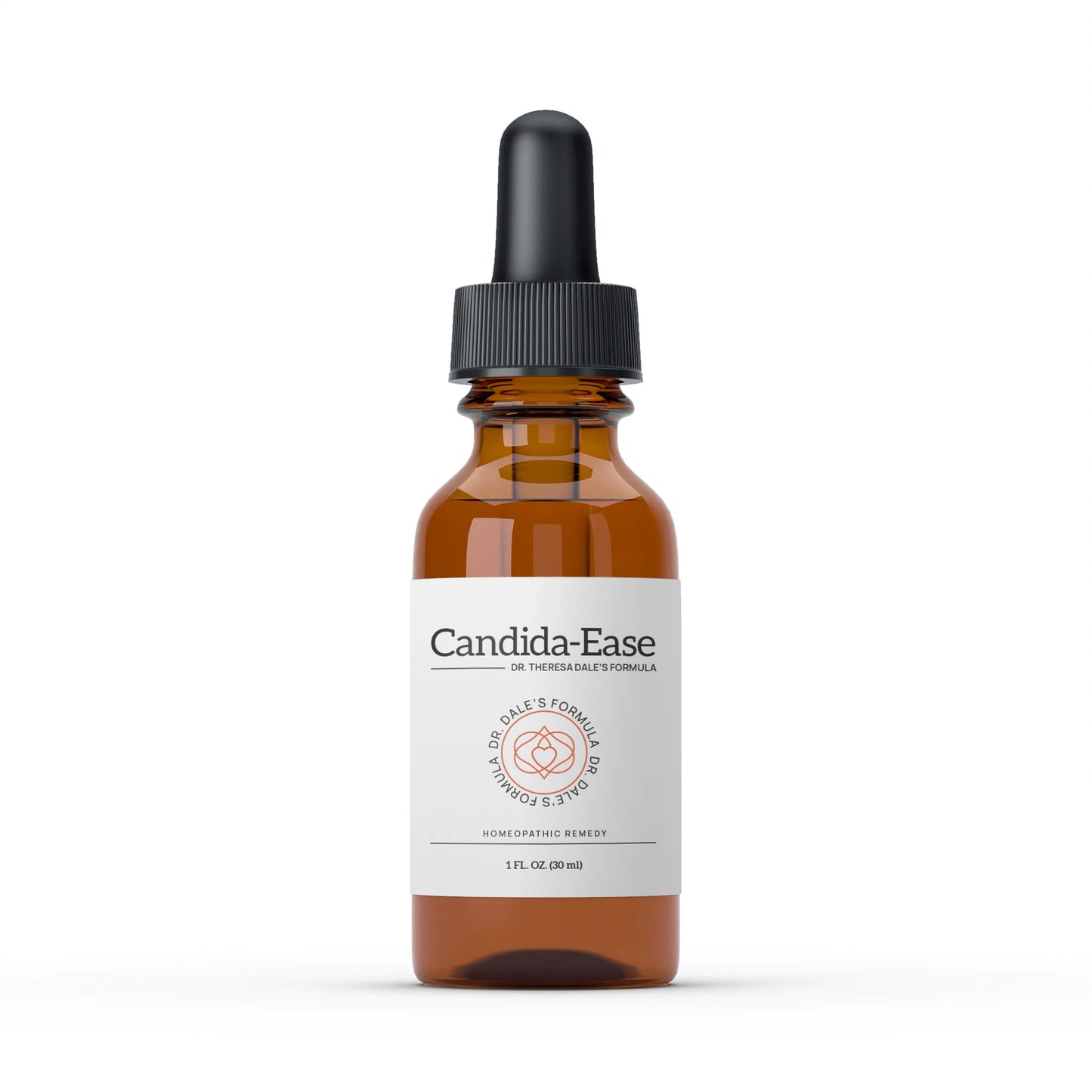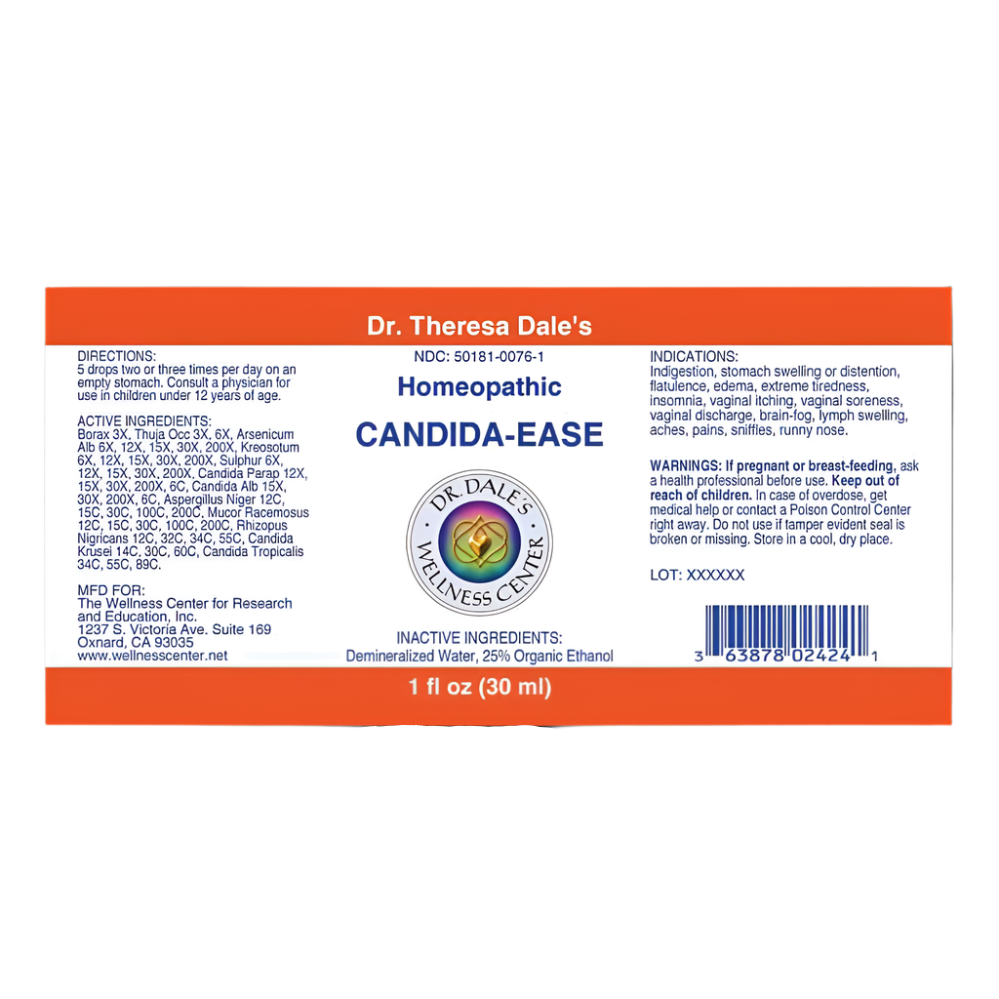1
/
of
3
Candida-Ease, Homeopathic Formula, Dr. Dale's
Candida-Ease, Homeopathic Formula, Dr. Dale's
Regular price
$36.99
Regular price
Sale price
$36.99
Unit price
/
per
Shipping calculated at checkout.
Out of stock
No reviews
Couldn't load pickup availability
 Our shipping is free over $100
Our shipping is free over $100
Overview
Overview
Dr. Dale's proprietary homeopathic formula in an advanced Homeopathic Homocord preparation, which includes the following. Active ingredients: Arsenicum Album 6X, Aspergillus Niger 12C, Borax 3X, Calcarea Carbonica 8X, Candida Albicans 8X, Candida Parapsilosis 8X, Candida Torresil 8X, Candida Tropicalis 8X, Conium Maculatum 6X, Kreosotum 6X, Lycopodium Clavatum 6X, Mucor Racemosus 12C, Pulsatilla 6X, Sepia 6X, Sulphur 6X Inactive ingredients: Demineralized Water, 25% Ethanol. Dosage: 5 drops two or three times per day on an empty stomach. Five days on, two days off. Yeast is a fungus scientifically referred to as Candida. The specific type of fungus most commonly responsible for vaginitis is Candida albicans. Yeast is commonly present on normal human skin and in areas of moisture, such as the mouth and vagina. In fact, up to 20% of women normally carry yeast in the vaginal area. What is Candida? A yeast-like fungal organism found in small amounts in the normal human intestinal tract. Normally kept in check by the body's own helpful bacteria, Candida Albicans can increase in numbers when this balance is disturbed to cause candidiasis of the intestinal tract, or yeast infections of other parts of the body. Candida Albicans causes thrush. Also called Monilia albicans. Vaginitis is inflammation of the vagina. Vaginitis is very common and is reported by as many as 75% of women at some point in their lives. Vaginitis can be caused by a number of infections, including bacteria (such as Gardnerella and gonorrhea), protozoans (such as trichomonas), and yeast (Candida). Vaginal yeast infection is often referred to as vaginal Candidiasis. What are the symptoms of vaginal yeast infection and vulvitis? Vaginal yeast infection (yeast vaginitis) and vulvitis cause symptoms that are nonspecific, which means that aside from the yeast infection, other conditions can cause the identical symptoms. The most common symptom of a vaginal yeast infection is itching in the vaginal and/or vulvar area. Other symptoms of vaginal yeast infection and vulvitis include: burning, soreness, pain during intercourse and/or urination, and vaginal discharge. Vaginal discharge is not always present, but when it occurs, the discharge is odorless and typically has a whitish, thick appearance and texture, like cottage cheese. Vulvitis can also cause local pain in addition to the above symptoms. Pain in the vulvar area is referred to as vulvodynia. In up to 5% of women, yeast vulvovaginitis may cause a recurrent problem. A recurrent yeast infection occurs when a woman has four or more infections in one year that are not related to antibiotic use. Recurrent yeast infections may be related to an underlying medical condition and may require more aggressive treatment. What is vulvitis? Vulvitis is inflammation of the external genital organs of the female (the vulva). The vulva includes the labia, clitoris, and entrance to the vagina (the vestibule of the vagina). An inflammation of the vulva is referred to as vulvitis. Vulvitis, like vaginitis, may be caused by a number of different infections. Because the vulva is also often inflamed when there is inflammation of the vagina, vaginitis is sometimes referred to as vulvovaginitis. What causes yeast vaginitis (vaginal yeast infections)? Vaginal yeast infections occur when new yeast is introduced into the vaginal area, or when there is an increase in the quantity of yeast already present in the vagina relative to the quantity of normal bacteria. For example, when the normal, protective bacteria are eradicated by antibiotics (taken to treat a urinary tract, respiratory, or other types of infection) or by immunosuppressive drugs, the yeast can multiply, invade tissues, and cause irritation of the lining of the vagina (vaginitis). Vaginal yeast infections can also occur as a result of injury to the inner vagina, such as after chemotherapy. Also, women with suppressed immune systems (for example those taking cortisone-related medications such as prednisone) develop vaginal yeast infections (yeast vaginitis) more frequently than women with normal immunity. Antibiotics kill all bacteria including friendly bacteria which helps keep our immune system strong. Other conditions that may predispose women to developing vaginal yeast infections include diabetes mellitus, pregnancy, and taking oral contraceptives. The use of douches or perfumed vaginal hygiene sprays may also increase a woman’s risk of developing a vaginal yeast infection. A vaginal yeast infection (yeast vaginitis) is not considered to be a typical sexually transmitted infection (STD), since Candida may be present in the normal vagina, and the condition does occur in celibate women. However, it is possible for men to develop symptoms after sexual intercourse with an infected partner. There are different species of Candida. The genus Candida includes around 154 species. Among these, four are most frequently isolated in human infections. While Candida albicans is the most abundant and significant species, Candida tropicalis , Candida parapsilosis , Candida Torresil are also isolated as causative agents of Candida infections. Pathogenicity Pathogenicity and Clinical Significance Infections caused by Candida spp. are in general referred to as candidiasis. The clinical spectrum of candidiasis is extremely diverse. Almost any organ or system in the body can be affected. Candidiasis may be superficial and local or deep-seated and disseminated. Disseminated infections arise from hematogenous spread from the primarily infected locus. Candida albicans is the most pathogenic and most commonly encountered species among all. Its ability to adhere to host tissues, produce secretory aspartyl proteases and phospholipase enzymes, and transform from yeast to hyphal phase are the major determinants of its pathogenicity. Candida tropicalis A major cause of septicemia and disseminated candidiasis, especially in patients with lymphoma, leukemia and diabetes. It is the second most frequently encountered medical pathogen, next to C. albicans, and is also found as part of the normal human mucocutaneous flora. Sucrose negative variants of C. tropicalis have also been increasingly found in cases of disseminated candidiasis. Environmental isolations have been made from faeces, shrimp, kefir, and soil. Candida Parapsilosis The Disease The yeast-like fungi of the genus Candida are an important cause of nosocomial infection, and rank fourth in bloodstream infections in the US. Candida albicans is the most common causative organism of these infections, but other Candida species, including Candida parapsilosis , are becoming increasingly prevalent. Candida parapsilosis is associated with approximately 25% of Candida infections in European hospitals, and in South America the incidence of this species increased from 12% to 25% between 1997 and 1999. It is now the second most commonly isolated Candida species from blood cultures in Europe, Canada and Latin America, and in some European hospitals even outranks Candida albicans . Unlike other Candida species, C. parapsilosis has been found on the hands of health care workers, resulting subsequent nosocomial infection associated with handling central venous catheters. C. parapsilosis is a particular problem as it tends to grow as biofilms on implanted medical devices, conferrin almost total resistance to antifungal drugs. The ability to grow as a biofilm is directly related clinically significant disease, which is a unique attribute of C. parapsilosis . The Organism C. parapsilosis strains have historically been categorised as Group I, II or III on the basis of molecular fingerprinting. Group I strains are predominant in clinical isolates. Analysis of levels of heterozygosity and of mitochondrial genome architecture supports the hypothesis that three groups represent three different species. It has been proposed that Group II and Group III isolates are are different species and should be renamed C. orthopsilosis and C. metapsilosis respectively. Group I isolates are therefore the most authentic and clinically relevant representatives of C. parapsilosis . The estimated diploid genome size of Candida parapsilosis is 26 Mb with a chromosome number of 14, suggesting a haploid genome of 13 Mb, with 7 chromosomes. The C. parapsilosis isolate 317 from CDC, Atlanta was selected for sequencing. This isolate came from the hands of a hospital worker, who was the source for an outbreak of infection in a Mississippi community hospital in 2001, and was characterized and described in Kuhn et al and Clark et al. Hot to treat Candida? Of course, with so many people suffering, the doctors couldn't brush our symptoms aside forever. Many more people are now being diagnosed with Chronic Fatigue Syndrome (CFS) or CFIDS (Chronic Fatigue and Immune Dysfunction), Fibromyalgia syndrome (FMS), Lupus, Hypothyroidism, Leaky Gut Syndrome, Crohn's Disease, Irritable Bowel Syndrome, Celiac Disease, chronic sinusitis, atopic eczema, Seborrheic Dermatitis, Tinea Versicolor, GI dysbiosis, adrenal dysfunction, Rosacea, Psoriasis, Macular Degeneration, Barrett's Esophagus, Lactose Intolerance, Gluten and/or Casein Intolerance, Meniere's Disease, Obsessive Compulsive Disorder (OCD), and sometimes just depression (which can accompany many disease states), just to name a few. It can be an underlying condition in many diseases, but is often not diagnosed, misdiagnosed, disputed to even exist or is disregarded altogether. (See Dr. Dale's Resources section for findings from Bruce Semon, M.D., Ph.D. regarding the effects of yeast overgrowth and Autism, ADD, ADHD, Tourette's, headaches, fatigue, depression and schizophrenia. William Shaw, M.D. addresses some of those issues as well as Alzheimer's). The number of children born with Autism 30 years ago was approximately 1 in 500,000. The approximate number today is a staggering 1 in 166. Alzheimer's alone has been predicted to break our healthcare system in the next 20 years. Symptoms The symptoms vary from person to person and fluctuate in severity, or may come and go. Most symptoms are invisible, which makes it difficult for others to understand the vast array of debilitating symptoms with which we contend. The most common symptoms are: an incapacitating fatigue problems with concentration and short-term memory flu-like symptoms such as pain in the joints and muscle extreme tightness in the shoulders and neck hyper-acidity/acid reflux brown colored mucus in the back of the throat blisters in the mouth/tongue/throat either white or "blood blisters" un-refreshing sleep sore throat white coated tongue dark circles under the eyes an aversion to being touched or jumping "crawling" skin chronic sinus problems and headaches including migraines chronic dental problems Visual disturbances may include blurring, sensitivity to light and eye pain. chills and night sweats shortness of breath dizziness and balance problems sensitivity to heat and/or cold alcohol intolerance gluten and/or casein intolerance irregular heartbeat irritable bowel constipation and/or diarrhea painful gas and abdominal bloating low-grade fever or low body temperature numbness, tingling and/or burning sensations in the face or extremities dryness of the mouth and eyes difficulty swallowing projectile vomiting Psychological problems may include depression irritability anxiety panic attacks recurring obsessive thoughts personality changes and mood swings (irrational rage or crying for no reason - fear of talking to people, any kind of confrontation, isolation) paranoia Also menstrual problems including PMS and endometriosis recurrent yeast infections recurrent ear infections rashes and dry, flaking skin eczema dermatitis acne skin discoloration and/or blotchiness dandruff jock and rectal itching chronic athlete's foot chronic toenail and fingernail fungus ringing in the ears (tinnitus) allergies and sensitivities to noise/sound, foods, odors, chemicals anemia weight changes without changes in diet light-headedness feeling in a fog fainting muscle twitching and muscle weakness restless leg syndrome low sex drive and/or numbness in the genital area These are only the symptoms most commonly reported and documented.
Share








